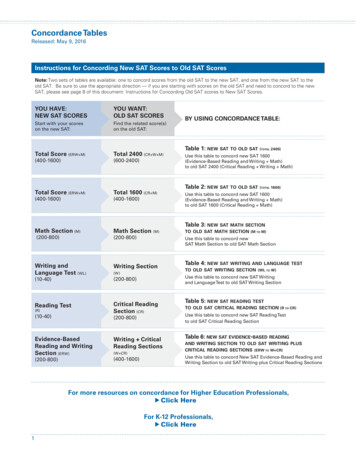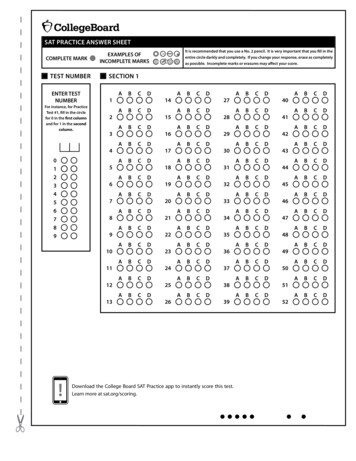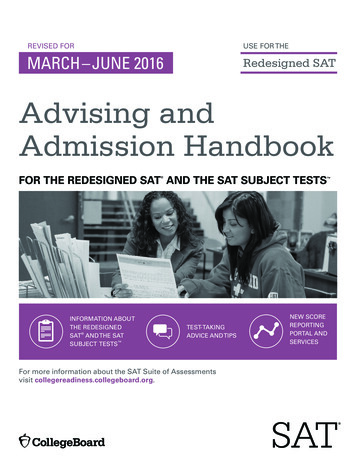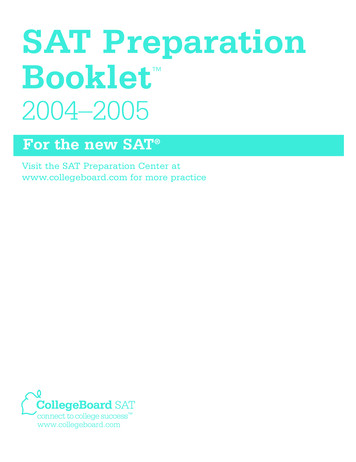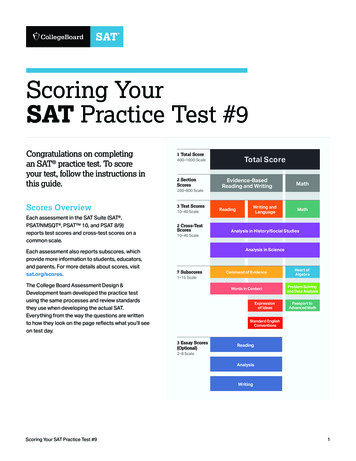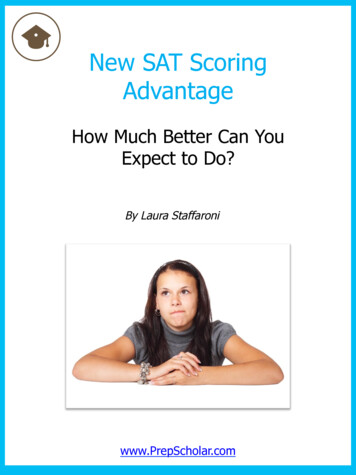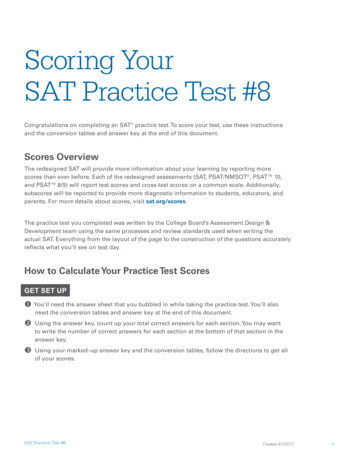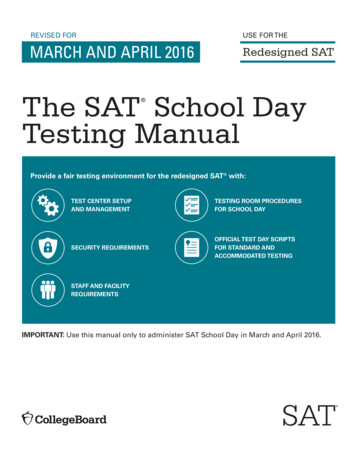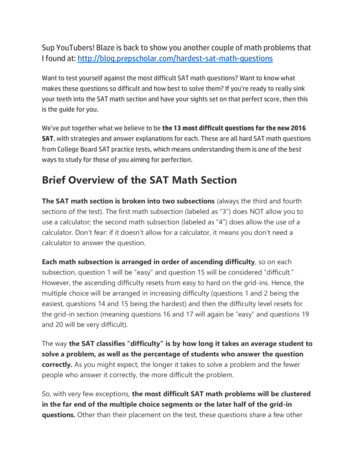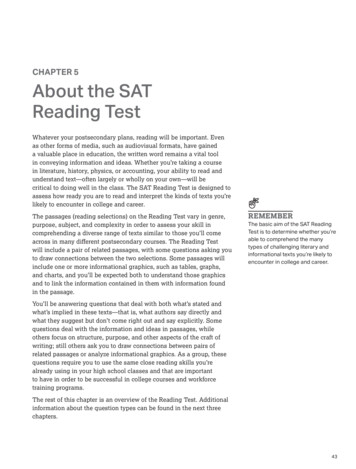
Transcription
CHAPTER 5About the SATReading TestWhatever your postsecondary plans, reading will be important. Evenas other forms of media, such as audiovisual formats, have gaineda valuable place in education, the written word remains a vital toolin conveying information and ideas. Whether you’re taking a coursein literature, history, physics, or accounting, your ability to read andunderstand text—often largely or wholly on your own—will becritical to doing well in the class. The SAT Reading Test is designed toassess how ready you are to read and interpret the kinds of texts you’relikely to encounter in college and career.The passages (reading selections) on the Reading Test vary in genre,purpose, subject, and complexity in order to assess your skill incomprehending a diverse range of texts similar to those you’ll comeacross in many different postsecondary courses. The Reading Testwill include a pair of related passages, with some questions asking youto draw connections between the two selections. Some passages willinclude one or more informational graphics, such as tables, graphs,and charts, and you’ll be expected both to understand those graphicsand to link the information contained in them with information foundin the passage.REMEMBERThe basic aim of the SAT ReadingTest is to determine whether you’reable to comprehend the manytypes of challenging literary andinformational texts you’re likely toencounter in college and career.You’ll be answering questions that deal with both what’s stated andwhat’s implied in these texts—that is, what authors say directly andwhat they suggest but don’t come right out and say explicitly. Somequestions deal with the information and ideas in passages, whileothers focus on structure, purpose, and other aspects of the craft ofwriting; still others ask you to draw connections between pairs ofrelated passages or analyze informational graphics. As a group, thesequestions require you to use the same close reading skills you’realready using in your high school classes and that are importantto have in order to be successful in college courses and workforcetraining programs.The rest of this chapter is an overview of the Reading Test. Additionalinformation about the question types can be found in the next threechapters.43
PART 2 Evidence-Based Reading and WritingReading Test PassagesThe passages on the Reading Test are as varied as those you’rereading now for your high school classes. Some are literary in nature,while others are primarily informational. They differ in purpose as well:Some tell a story, while others share information, explain a processor concept, or try to convince you to accept or do something. Theyalso cover a wide range of subjects. Some passages are particularlychallenging, while others are more straightforward. In addition, somepassages are paired, and others are accompanied by one or moreinformational graphics.Here are some of the key features of Reading Test passages.§ §Genre: The Reading Test includes both literary and informationalpassages. Literary passages are primarily concerned with telling astory, recounting an event or experience, or reflecting on an idea orconcept. The Reading Test includes both a fiction selection and aselection from a historically or culturally important document, suchas a speech, essay, or letter. Informational passages, as the nameimplies, are mostly concerned with conveying information andideas.§ §Purpose: As noted above, some Reading Test passages are mainlyPRACTICE ATsatpractice.orgYou may find that you’re better atreading and interpreting passagesfrom one subject area—history/social studies, for instance—thanfrom others. It’s important, therefore,to practice reading and answeringquestions about passages fromall three subject areas on theSAT Reading Test (U.S. and worldliterature, history/social studies, andscience). In fact, consider devotingmore practice time to the type(s) ofpassages you’re less comfortablereading.44focused on telling a story, recounting an event or experience,or reflecting on an idea or concept. Other passages presentinformation and ideas or explain a process or concept. Stillother passages are best described as arguments. Their goal is toconvince readers through the use of evidence, reasoning, and/orstylistic and persuasive techniques to believe something or to takesome sort of action.§ §Subject: The Reading Test includes passages in three majorsubject areas: U.S. and world literature, history/social studies,and science. Literature passages are selections from classic andmore recent works of fiction by authors from the United Statesand around the world. History/social studies passages includeselections from fields such as economics, sociology, and politicalscience. This category also includes selections from U.S. foundingdocuments and similar texts in the Great Global Conversationabout civic and political life written by authors from the UnitedStates and other nations. Science passages deal with information,concepts, and experiments in the fields of Earth science, biology,chemistry, and physics.§ §Complexity: The reading challenge posed by the passages on thetest varies. Some passages are relatively straightforward. Theymay, for example, have a very clear purpose, present a fairly smallamount of information, and use familiar language. Other passages,by contrast, are more complex. They may have multiple levels of
Chapter 5 About the SAT Reading Testmeaning (such as a literal and a metaphorical level), require thereader to follow a complicated series of events, and make useof long and involved sentences. (It’s important to note here thateach administration of the Reading Test has a similar range ofpassage complexity, so you shouldn’t worry about getting a testthat has nothing but highly complex passages.) Chapter 9 includesexamples of low- and high-complexity passages to give you a senseof the spread of difficulty you’ll see on the test.Two other features of passages are important as well.§ Paired passages: Each administration of the Reading Test includesa pair of related passages. These passages are on the same topicand interact with one another in some way. They may, for instance,present different perspectives or opinions on a topic, with the firstpassage taking one position and the second passage another.In other cases, the two passages may simply contain differentinformation on the same topic. One may be a general overview, forexample, while the other zeroes in on one particular element. Theset of associated questions will ask about each passage separatelyas well as about both passages together. History/social studies andscience passages may be paired.§ Informational graphics: Some passages include one or moretables, graphs, charts, and the like that correspond to the topic ofthe passage. A graphic may, for instance, display the results ofan experiment described in the passage. Questions may ask youto locate information in the graphic, draw reasonable conclusionsabout the graphic’s data, or make connections between the graphicand the passage. Graphics appear with one of the history/socialstudies and one of the science passages.All of the passages on the Reading Test come from previouslypublished, high-quality sources. The Reading Test always includes:REMEMBERTwo passages on the SAT ReadingTest will include one or moreinformational graphics—tables,graphs, charts, or the like. Relatedquestions will assess your skill inlocating and interpreting informationin the graphic(s) and integrating thatinformation with information andideas in the passage.§ One passage from a classic or contemporary work of U.S. or worldliterature.§ §One passage or a pair of passages from either a U.S. foundingdocument (such as an essay by James Madison) or a text in theGreat Global Conversation (such as a speech by Nelson Mandela).§ §One passage on a social science topic from a field such aseconomics, psychology, or sociology.§ §Two science passages (or one passage and one passage pair) thatexamine foundational concepts or recent developments in Earthscience, biology, chemistry, or physics.45
PART 2 Evidence-Based Reading and WritingReading Test QuestionsAll Reading Test questions are multiple-choice and have four answeroptions. To decide which of the four answer choices makes the mostsense, you’ll want to consider what’s stated and implied in the passage(or passage pair), along with any supplementary material (such as atable or graph). The questions follow something of a natural order.You’ll find questions about the passage as a whole—questionsabout the main idea or point of view, for example—early on in eachset, while questions about specific parts of the passage come later.Questions about graphics and questions linking paired passagestypically come near the end of the sequence.REMEMBERWrong answer choices are oftentempting. You must, therefore, baseyour answer on a close reading andinterpretation of the passage andany associated graphics.REMEMBERAll of the information you needto answer the questions can befound in the passages themselvesor in supplementary material suchas graphics. You won’t be testeddirectly on your backgroundknowledge of the specific topicscovered. In fact, be careful ifapplying outside knowledge to apassage or its questions, as thismay skew your interpretation.The questions are meant to be like those that you’d ask or answer in alively, serious discussion about a text. Think of the kinds of questionsyou’d be asked to consider in your favorite, most engaging class,and you’ll have the general idea of what’s on the Reading Test. Thequestions aren’t intended to be tricky or trivial, although some will bequite challenging and will require careful reading and thinking. They’redesigned to determine whether you’re reading closely and makingreasonable interpretations, so expect to see some answer choices thatmay seem right or fit your preconceptions but that don’t match up withwhat an author is saying.The questions also often reflect the specific sort of passage you’rereading. A literature question may ask you to think about plot orcharacter, but a science question won’t; instead, it may ask aboutthings such as hypotheses and experimental data. Although passagesare taken from texts on various subjects, the questions don’t directlytest your background knowledge of the specific topics covered. All ofthe information you’ll need to answer the questions can be found inthe passages themselves (or in any supplementary material, such as agraphic).Reading Test questions fall into three general categories:(1) Information and Ideas, (2) Rhetoric, and (3) Synthesis. Thequestions won’t be labeled this way on the test, and it’s not crucialthat you understand all of the differences. A brief explanation of eachcategory, though, should help you get a sense of what you’ll encounter,what knowledge and skills are covered, and how better to prepare forthe test.§ §Information and Ideas: These questions focus on the author’smessage. In these sorts of questions, you’ll be asked to locatestated information, make reasonable inferences, and apply whatyou’ve read to another, similar situation. You’ll also be askedto figure out the best evidence in the passage for the answer toanother question or the best support for a conclusion offered inthe question itself. You’ll also have to determine central ideasand themes, summarize important information, and understand46
Chapter 5 About the SAT Reading Testrelationships (including cause-and-effect, comparison-contrast, andsequence). Other questions will ask you to determine the meaningof words and phrases as they’re used in particular contexts.§ §Rhetoric: These questions focus your attention on how an authorputs together a text and how the various pieces contribute to thewhole text. You’ll be asked to think about how an author’s wordchoice shapes meaning, tone, and style. You’ll also be asked toconsider how a passage is structured and what roles its variousparts (such as particular details) play. Questions about theauthor’s point of view and purpose are also part of this category,as are questions about the claims, reasons, evidence, and stylisticand persuasive elements (such as appeals to fear or emotion)found in arguments. The common thread tying these questionstogether is their emphasis on the author’s craft. Instead ofthinking about the author’s message per se, you’ll be thinkingabout how the author constructs a text to make its message clear,engaging, informative, or convincing.§ §Synthesis: Unlike questions in the other two categories,Synthesis questions only accompany certain passages. Theycome in two basic forms. Some Synthesis questions ask you todraw connections between a pair of passages. For example, aquestion may ask how the author of the first passage in a pairwould most likely react to a claim made by the author of thesecond passage. A question may instead ask you something moregeneral, such as how the two passages are similar or different incontent, form, style, or perspective. Other Synthesis questionsask about informational graphics. In these, you may have to finda particular piece of data, figure out which conclusion is themost reasonable given a certain set of results from a study, orintegrate information from a table with the information and ideasfound in the passage itself.The Reading Test in OverviewHaving a general sense of how the Reading Test is put together willhelp you to prepare for the test and pace yourself during the test itself.§ Total Questions: 52§ §Total Time: 65 minutes (on average, a minute and 15 seconds perquestion, inclusive of passage reading time)§ §Number of Passages: Four single passages plus one pair ofpassages§ §Passage Length: 500 to 750 words; approximate total of 3,250 words§ §Passage Subjects: One U.S. and world literature passage, twohistory/social studies passages (one in social science andone from a U.S. founding document or text in the Great GlobalConversation), and two science passages47
PART 2 Evidence-Based Reading and Writing§ §Passage Complexities: A defined range from grades 9–10 to earlypostsecondary§ Questions per Passage: 10 or 11§ §Scores: In addition to an overall test score, the questions on theReading Test contribute to various scores in the following ways:w wCommand of Evidence: 10 questions, generally two perpassagew wWords in Context: 10 questions, generally two per passagew wAnalysis in History/Social Studies: 21 questions (all of thequestions on the two history/social studies passages)w wAnalysis in Science: 21 questions (all of the questions on thetwo science passages)NOTE: Some Reading Test questions don’t contribute to any of these scores (just to theoverall test score), and some history/social studies and science questions (such asvocabulary questions) may contribute to two of these scores.Chapter 5 RecapThe SAT Reading Test measures your skill in reading andcomprehending texts of varied genres, purposes, subjects, andcomplexities. The questions on the test are all multiple-choice, mirrorthose that you’d encounter in a good class discussion, and cover threebasic areas: Information and Ideas, Rhetoric, and Synthesis. All ofthe questions can be answered based on what’s stated or implied inthe passages (and in any supplementary material provided), and noquestion tests background knowledge of the topic. Each administrationof the test includes one passage pair, and two passages (one inhistory/social studies, one in science) include an informational graphicor graphics.PRACTICE ATsatpractice.orgDevote ample practice time toreading passages efficiently andstrategically, considering the typesof things you’ll likely be asked in SATquestions. With practice, you’ll findthat you can read passages morequickly and gain a stronger grasp ofthe content, structure, and author’spurpose.48There’s quite a bit to read on the test and also a fair number ofquestions; the length of the test, however, is balanced by three factors.First, the passages, while often challenging, are like those that you’reprobably already reading for your high school classes, and they covermany of the same subjects as well. Second, the questions deal withimportant aspects of the passages rather than trivia, so if you grasp thecentral ideas and key details of each passage, you’re more likely to dowell. Finally, enough time is provided (65 minutes) so that you shouldbe able to answer the questions without a lot of rushing as long as youmaintain a good, consistent pace and watch the clock.
to practice reading and answering questions about passages from all three subject areas on the SAT Reading Test (U.S. and world literature, history/social studies, and science). In fact, consider devoting more practice time to the type(s) of passages you’re less comfortable reading. § Genre: The Rea


